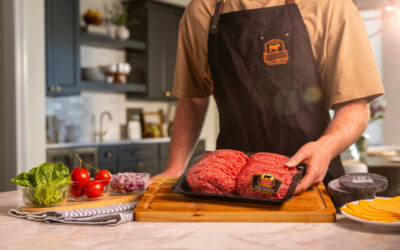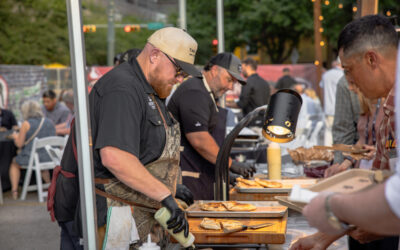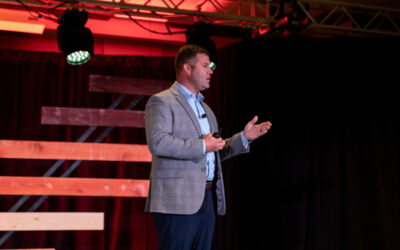
Nice to Meat Ya: Meg and Matt Groves
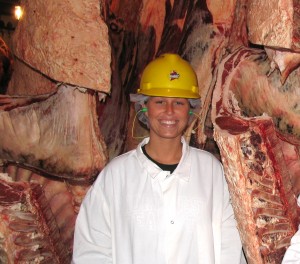
As the carcass data manager for the Tri-County Steer Carcass Futurity (TCSCF )—probably the most well-known and largest feedout discovery program in the nation—she takes her job very seriously. More than five minutes late to one of those early morning meet ups? You get left. Being a man short is better than the alternative.
“If you miss the kill order….well, that’s everything. You can’t just go back the next day,” she says. Neither snooze button nor snowstorm will keep them from gathering the marbling, backfat and KPH (Kidney Pelvic and Heart Fat) information. If there’s winter weather on the way, they stay in a hotel the night before.
During a high volume season, Meg is in the packing plant almost every day. One day she and a coworker take down the “tag transfer” data, matching the eartag number with the plant ID. The following day, four or five of the crew head into the cooler, taking carcass notes right next to the USDA grader. The line runs fast, so they must be focused and efficient.
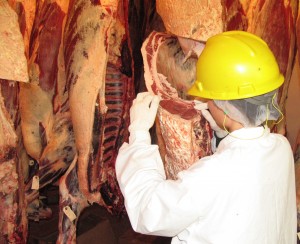
TCSCF analysis helped uncover truths like this: it doesn’t matter where the cattle come from, but rather how they’re handled; the calmer the cattle, the better they’ll grade; and keeping cattle healthy pays dividends. The list could go on, as these studies and abstracts are constantly cited in presentations and scientific literature, proof of their impact.
It’s almost unlikely that Meg would find herself in such an important position in the cattle business.
“I was always terrified of animals growing up,” she laughs, noting her upbringing on a farm 30 miles away. “I’ve grown to really like and enjoy it.”
Getting up early and working in a packing plant—sound like your dream job? How about working alongside your brother?
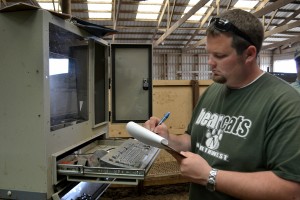
Matt Groves, two years Meg’s junior, actually says it’s a perk. Meg had already worked at the TCSCF for a handful of years when her brother started as the feedlot data coordinator in 2010. In that position he also intensively manages data—they weigh cattle five times while they’re on feed, for example. He’s often found right beside Meg in the plant, but also places cattle in the yards, processes and tags and sorts for finish.
“We’ve got a really good set of feedlots. They’re all very progressive,” Matt says. The facilities and the people help make his job easier.
He runs cows and helps his dad farm, so Matt is glad to be close to the “home place.” It also makes those predawn work-day beginnings a little easier. “It’s nice to get my hours in early and then have that ‘free time.’”
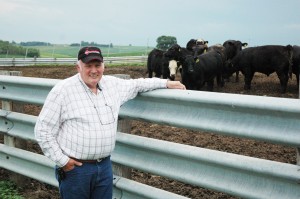
Ushering thousands of cattle through feeding and processing each year, these siblings make it possible for cattlemen from across the country to learn more about how their animals do post-weaning, and perhaps even more importantly, they allow TCSCF manager Darrell Busby to continue making discoveries that improve the entire beef industry.
Simply put, they’re enablers, of the very best variety.
May your bottom line be filled with black ink,
Miranda
PS–Want to catch up on the whole series? Check out these links below:
- Introduction: Nice to Meat Ya
- Day 1: Ashley Pado
- Day 2: Scott Redden
- Day 3: Jesse Stucky
- Day 4: Bridget Wasser
- Day 5: Amanda Barstow
- Day 6: Josh Moore
- Day 7: Ruth Ammon
- Day 8: Bill Tackett
- Day 9: Dan Chase
- Day 10: Danielle Foster
- Day 11: Eric Mihaly
- Day 12: Jennifer Kiko
- Day 13: Mark Morgan
You may also like
Success, Despite Challenges
Today’s market is complex and competitive. The collective effort of stakeholders across the supply chain positions Certified Angus Beef to meet the record demand for premium beef moving forward. Signals across the beef industry are clear and Angus farmers and ranchers seeking high-quality genetics that deliver premium beef are producing a product in high demand.
Keep the Supply Coming
A record-high 800 registrants from 17 countries gathered in Austin, Texas, to learn more about CAB, become inspired by the culinary work of chefs and pitmasters, and celebrate sales and production success. But at the forefront: supply and demand, a reflection of the chaotic past year, and preparing for what’s ahead.
Consumer Demand, Power of Quality
Demand for high-quality beef persists. But with that demand comes challenges. From tight cattle supplies to higher costs and increasing pressure on retailers to deliver a consistent eating experience, the pressure is on. David O’Diam, CAB VP of retail, addressed the current retail beef environment, highlighting both opportunities and challenges in today’s marketplace.

